Waseda Grad Ceremony
Monday, March 29th, 2010 in: News, Travel
In Japan, there are several cultural events that help to perpetuate the perception of Japan as a homogenous society. These events help create a strong shared public memory, and tighten the bonds between colleagues, further embossing the Japanese character with the concept of 外 and 内, in and out crowds. National holidays, seasonal events, and shared experiences that everyone experiences so they can relate to each other, but even moreso, to bond with the people with whom they celebrate the events.
The entering and graduation from schools plays a big part in the average Japanese person’s life. Everyone gathers together, wearing similar outfits and listens to speeches about their memorable experience and optimism for the future, looking forward to the next logical step in their collective lives. For the school-bound, it’s the next level in their education; for the career-oriented, it’s their entry into the workforce, their completion of 就職活動 and their graduation into the official adult world. Afterward, everyone gathers into their sub-groups and celebrates accordingly: they take photos with each other, then drink themselves silly.
Since I decided to come to Tokyo a little earlier, I was able to attend the Waseda graduation. I skipped the ceremony itself, as my friends were graduating in different groups (again, each area of study being a subgroup of the entire graduating class, with different speakers at different ceremonies). We arrived at Waseda station a little after 1, and were immediately swarmed by crowds of people wearing Hakama, the traditional graduation outfit in Japan. Unlike in the states, where everyone is dressed in the same cap and gown, Japanese graduation ceremonies give the students the opportunity to put on something that actually differentiates themselves from one another. Almost every hakama we saw were unique, much like the kimonos for seijinshiki (the coming of age ceremony, another shared event in the Japanese life). It wasn’t even a requirement, as most of the men were in suits. I spotted a few mortarboards and gowns in the crowd, but the outfit of choice was by far the colorful traditional Hakama. The weather was miserable (a short cold front that happens annually around this time, called 花冷え, the flower frost), so the crowd was thick with umbrellas poking at each other.
Kaoru and I made our way to the Okuma statue in the heart of the campus. The newly constructed building 11 loomed overhead. The new home of the SILS program, building 11’s presence and location are a bit of a metaphor for the school’s attitude towards its exchange programs and international appeal. There are now almost four thousand foreign students studying at Waseda, and building 11 is right in the thick of things. When I was studying there, they were still laying the foundation for the building and the exchange students were relegated to buildings on the outskirts of campus. Now it seems the focus has shifted.
We met up with Willy, one of my fellow 06-07 alums. He and Ehtesham had come for their friend’s wedding (their friend being the guy from Junmen who sold me my slick Japanese suit back when I worked as an English teacher. As I said in my JAlumni video, you never know the role people you meet will play in your life later on. Ehtesham was laid up sick in the hotel, so he wasn’t able to come out. Aya came out to visit us and we took our photos together, then went to the Niji no kai lounge to meet with Takahiro.
A bit of background: Niji no kai is one of the groups that helped take care of the exhange students when we first got to Japan (WIC being the other main group). Most of my Japanese friends are from one of these clubs, including Aya, Kaoru and Maho, Ayaka, Takahiro and Yoshie (the last three stayed with me in Sacramento in the fall of 08 during their trip across America). Takahiro was also graduating today, and looked sharp in his suit. We went to the new building 11 to check it out and kill some time. The student lounge was full of people in all states of attire. Takahiro had some things to take care of so he bid us adieu for the moment.
We were headed to the other end of campus and randomly ran into Teru, former president of WIC and one of the few people I knew I had to see at the graduation. He was dressed in the traditional gakuran and cap of a Waseda student. A big fan of his university, Teru could’ve been in the Ouendan (traditional school cheer club) if he wanted. We snapped some photos and he assured us he was going to be prime minister some day. He was accepted into the cultural bureau (responsible for the Yokoso Japan! tourism campaign), which is exceedingly hard to get into. Teru is a good example of Gambariya (someone who does their best to follow their dreams). He didn’t get into Waseda the first time, but he had his heart set on it, so he became a roninsei for a year and got in the second time around. I mentioned I was looking for Kazaoka-sensei and he whipped out his phone and called her. Since it was still vacation, she had the week off, and then was taking the CSU students on the Kyoto trip the following week. I assured her I had plenty of time so I would see her when they get back.
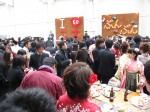 The Bungakubu cafeteria was swarming with Hakama, already starting their night of drinking. Some yelling, some cheering, and a whole lot of “kampai!”s filled the halls with the sounds of celebration. We found Tooru, used to have long brown hair, and was now sporting a short black ‘do. It’s just the way of things, he reassures us. Trading one uniform for another; you got to play by the rules and blend in to move through life at times.
The Bungakubu cafeteria was swarming with Hakama, already starting their night of drinking. Some yelling, some cheering, and a whole lot of “kampai!”s filled the halls with the sounds of celebration. We found Tooru, used to have long brown hair, and was now sporting a short black ‘do. It’s just the way of things, he reassures us. Trading one uniform for another; you got to play by the rules and blend in to move through life at times.
I got a call from Takuma and we arranged to meet for dinner with him and Jaime. Kaoru’s phone stopped working so we made our way to the Softbank store at Baba, where they basically said there was nothing they could do for her at the moment. We were both hungry, so we decided to take some lunch at Malabar, one of my favorite old Indian restaurants by the station. All-you-can-eat Naan lunch specials, never fail to satisfy. I told the maitre’d that I used to come here as a student, and I’m glad they’re still doing well and making great food. He thanked me and told me to make time to visit again before I leave.
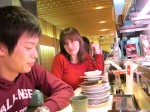 In Ochiai station we waited to meet with Takuma and Jaime and go for some kaiten zushi. We’d miscalculated our eating schedule so I skipped the sushi and just had a slice of cake instead. I’d come for the conversation anyways. Takuma and Jaime didn’t fail to provide the entertainment. They make a good couple, and are kind of hilarious together. I didn’t really know Jaime that well since we’d only briefly met when I came back from Waseda, so I didn’t realize how funny she could be, but she’s a good fit for Takuma. Jaime will be gone next week on one of the amazing CSU trips, so I might have him all to myself. she even offered me her key while she was gone. I’m touched by their generosity, so much so I’m going to try not to take advantage of it by finding someplace else to stay the night before she leaves for the Kyoto trip).
In Ochiai station we waited to meet with Takuma and Jaime and go for some kaiten zushi. We’d miscalculated our eating schedule so I skipped the sushi and just had a slice of cake instead. I’d come for the conversation anyways. Takuma and Jaime didn’t fail to provide the entertainment. They make a good couple, and are kind of hilarious together. I didn’t really know Jaime that well since we’d only briefly met when I came back from Waseda, so I didn’t realize how funny she could be, but she’s a good fit for Takuma. Jaime will be gone next week on one of the amazing CSU trips, so I might have him all to myself. she even offered me her key while she was gone. I’m touched by their generosity, so much so I’m going to try not to take advantage of it by finding someplace else to stay the night before she leaves for the Kyoto trip).
We headed back to Baba for the Niji no kai drinking party. A huge crowd of people piled into the izakaya to begin their two hours of frantic drinking, shouting, singing and bonding. I was starting to come down with a cold, and Kaoru didn’t seem too keen on doing a lot of drinking, so we decided to pop in just long enough to meet and greet a few folks before heading out. I felt a little bad for not being able to hang out longer, but I’m sure I would have felt worse if I had stayed. Besides, most of the students there weren’t around when I was studying, so our association through the club was a rather tenuous one. Since I had begun to arrange a get-together of some of my colleagues for the following Monday, I would have my chance to hang out with my own in-crowd. After all, that’s what Japan is all about.
I didn’t regret my decision to head home early, as I realized soon after my head hit the pillow just how exhausted I was.


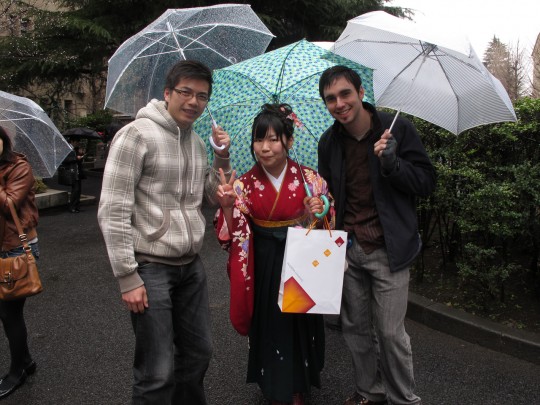
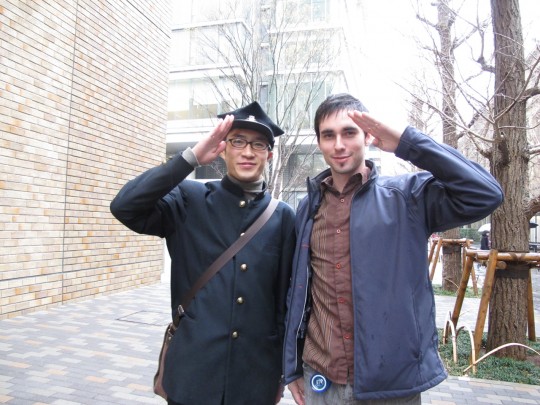


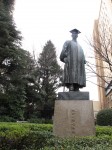


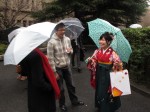
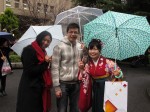
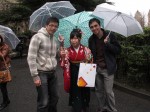
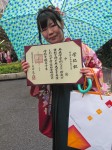


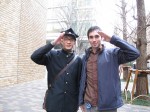
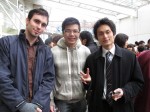



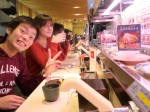
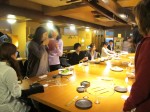
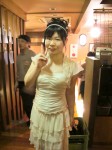








I regret that I missed out on seeing so many cute girls in kimono.